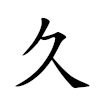久
See also: 乆
Translingual
| Stroke order | |||
|---|---|---|---|
| Stroke order | |||
|---|---|---|---|

| |||
Han character
久 (Kangxi radical 4, 丿+2, 3 strokes, cangjie input 弓人 (NO) or 難弓人 (XNO), four-corner 27800, composition ⿸𠂊乀)
Derived characters
Descendants
- く (Hiragana character derived from man'yōgana)
- ク (Katakana character derived from man'yōgana)
- 𛀫 (Hentaigana)
- 𛀬 (Hentaigana)
References
- Kangxi Dictionary: page 81, character 19
- Dai Kanwa Jiten: character 118
- Dae Jaweon: page 165, character 6
- Hanyu Da Zidian (first edition): volume 1, page 33, character 3
- Unihan data for U+4E45
Chinese
| simp. and trad. |
久 | |
|---|---|---|
| alternative forms | 乆 | |
Glyph origin
| Historical forms of the character 久 |
|---|
|
References:
Mostly from Richard Sears' Chinese Etymology site (authorisation),
|
Pictogram (象形) - a man receiving moxibustion. The derivative 灸 refers to the original word.
Pronunciation
- Mandarin
- (Standard Chinese)+
- Hanyu Pinyin:
- Zhuyin: ㄐㄧㄡˇ
- Tongyong Pinyin: jiǒu
- Wade–Giles: chiu3
- Yale: jyǒu
- Gwoyeu Romatzyh: jeou
- Palladius: цзю (czju)
- Sinological IPA (key): /t͡ɕi̯oʊ̯²¹⁴/
- (Standard Chinese)+
- Cantonese
- (Standard Cantonese, Guangzhou–Hong Kong)
- Jyutping: gau2
- Yale: gáu
- Cantonese Pinyin: gau2
- Guangdong Romanization: geo2
- Sinological IPA (key): /kɐu̯³⁵/
- (Standard Cantonese, Guangzhou–Hong Kong)
- Hakka
- (Sixian, incl. Miaoli and Meinong)
- Pha̍k-fa-sṳ: kiú
- Hakka Romanization System: giu`
- Hagfa Pinyim: giu3
- Sinological IPA: /ki̯u³¹/
- (Meixian)
- (Sixian, incl. Miaoli and Meinong)
- Southern Min
Note:
- kiú - literary;
- kú - vernacular.
- (Teochew)
- Peng'im: gu2
- Pe̍h-ōe-jī-like: kú
- Sinological IPA (key): /ku⁵²/
- Middle Chinese: kjuwX
- Old Chinese
- (Baxter–Sagart): /*[k]ʷəʔ/
- (Zhengzhang): /*kʷlɯʔ/
Definitions
Compounds
Lua error in Module:zh/templates at line 32: This template has been deprecated. Please use Template:col3 instead.
Japanese
Kanji
久
Readings
- Go-on: く (ku, Jōyō †)
- Kan-on: きゅう (kyū, Jōyō)←きう (kiu, historical)
- Kun: ひさしい (hisashii, 久しい, Jōyō)
- Nanori: きゅ (kyu); わ (wa); なが (naga); ひさ (hisa); ひさし (hisashi)
Compounds
Proper noun
久 or 久 • (hisashi or proper) [[Category:Japanese Lua error in Module:debug at line 160: Invalid part of speech.
|ひさし]]
- a male given name
Korean
Hanja
- This term needs a translation to English. Please help out and add a translation, then remove the text
{{rfdef}}.
Vietnamese
Alternative forms
Han character
久: Hán Việt readings: cửu (
久: Nôm readings: cửu[4]
References
Categories:
- Translingual lemmas
- Translingual symbols
- Han script characters
- Han characters from which hiragana were derived
- Han characters from which katakana were derived
- Han pictograms
- Mandarin terms with audio links
- Middle Chinese lemmas
- Old Chinese lemmas
- Chinese lemmas
- Mandarin lemmas
- Cantonese lemmas
- Hakka lemmas
- Hokkien lemmas
- Teochew lemmas
- Chinese adjectives
- Mandarin adjectives
- Cantonese adjectives
- Hakka adjectives
- Hokkien adjectives
- Teochew adjectives
- Chinese proper nouns
- Mandarin proper nouns
- Cantonese proper nouns
- Hakka proper nouns
- Hokkien proper nouns
- Teochew proper nouns
- Chinese terms with IPA pronunciation
- Chinese Han characters
- Mandarin terms with usage examples
- Chinese surnames
- Beginning Mandarin
- Japanese Han characters
- Grade 5 kanji
- Japanese kanji with goon reading く
- Japanese kanji with kan'on reading きゅう
- Japanese kanji with historical kan'on reading きう
- Japanese kanji with kun reading ひさ-しい
- Japanese kanji with nanori reading きゅ
- Japanese kanji with nanori reading わ
- Japanese kanji with nanori reading なが
- Japanese kanji with nanori reading ひさ
- Japanese kanji with nanori reading ひさし
- Japanese terms with multiple readings
- Japanese terms spelled with fifth grade kanji
- Japanese terms written with one Han script character
- Japanese terms spelled with 久
- Japanese single-kanji terms
- Japanese given names
- Japanese male given names
- Korean lemmas
- Korean Han characters
- Vietnamese Chữ Hán
- Vietnamese lemmas
- Vietnamese Han characters
- Vietnamese Nom
















